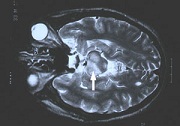Behcet Disease
Top Contributors - Jennifer Edwards, Sehriban Ozmen, Elaine Lonnemann, Admin, Kim Jackson, 127.0.0.1, Laura Ritchie, Wendy Walker, WikiSysop and Lucinda hampton
This article is currently under review and may not be up to date. Please come back soon to see the finished work! (05/09/2023)
Definition/Description[edit | edit source]
A syndrome (or sometimes referred to as a disease) that causes inflammation in the blood vessels of the body. The most common symptoms are sores in the mouth, sex organs, and on the skin, as well as swelling in the eye, pain, stiffness, and swelling in the joints. The more serious complications include meningitis, blood clots, inflammation of the gastrointestinal (GI) tract, and blindness. [1][2]
The video below is a great introduction to the topic provided by the American Behcet's Disease Association (ABDA), featuring a piece of educational information as well as patients' stories.
Prevalence[edit | edit source]
Occurs in people among the " Silk Road"- in the eastern Mediterranean, Middle East,and East Asia. Most common in males along the Silk Road countries and more common in females in Europe and the U.S. aged 25-30 years.[4]
- Estimated 15,000 in U.S. with Behcet's.
Pathological Process[edit | edit source]
The etiology is unknown but thought to be secondary to an autoimmune reaction, where the immune system attacks and harms the body's tissues, resulting in inflammation. Some thoughts are that it could have a genetic component making some more susceptible to a possible environmental trigger such as a virus or bacterium. [4]
Clinical Presentation[edit | edit source]
The patient could present with any of the five most common symptoms of Behcet's disease.
- Mouth sores- usually the first and most persistent symptom. They are similar to canker sores but have a longer duration and are usually larger and more painful.
- Genital sores- less common, but still occur in more than half of the patients with this disease. They are usually mistaken as genital herpes and can be on the external or internal surface of the genitalia. File:Behcet's D.JPGSkin lesion on Scrotum
- Skin lesions- are red, raised bumps or bruises that resemble boils or acne. They usually appear on the legs and upper torso.
- Uvelitis and retinal vasculitis- occuring in half the Behcet's patients, this can cause blurred vision, pain, redness, or blindness if left untreated.
- Arthritis- it results in inflammation in the joints leading to edema, heat, redness, and pain. It occurs in half the Behcet's patients and lasts a few weeks.
In addition to these five common clinical symptoms that patients present with, the circulatory, central nervous systems, and digestive tract can be affected.
- Circulatory system- DVT, aneurysms
- Central nervous system- may experience fever, headache, stiff neck, and difficulty coordinating movements secondary to inflammation in the meninges in the brain and spinal cord.
- Digestive tract- may lead to abdominal pain, diarrhea, and bleeding due to inflammation and ulcers in GI tract. These symptoms are similar to ulcerative colitis and Crohn's disease. [4]
Associated Co-morbidities[edit | edit source]
Include: ulcerations in mouth, genitals, and GI tract, skin lesions, lung aneurysms, arthralgias, headaches, confusion, strokes, personality changes, dementia, and aseptic meningitis, anterior/posterior uveitis [5]
Systemic Involvement[edit | edit source]
Can affect the eyes, mouth, skin, lungs, joints, brain, genitals, and GI tract.
- Eyes: May cause anterior/ posterior uveitis; anterior uveitis results in pain, blurry vision, tearing, redness, and light sensitivity; posterior uveitis causes fewer symptoms but damages the retina.
- Mouth: Painful sores called aphthous ulcers can be found on the lips, tongue, and inside of the cheek.
- Skin: Erythema nodosum which are red, tender nodules that can occur on the legs and ankles commonly, but also on the face, neck, and arms or pustular skin lesions which resemble acne.
- Lungs: Aneurysms in arteries of lungs--> which can lead to hemorrhage.
- Joints: Arthralgias
- Brain: Headaches, confusion, strokes, personality changes, dementia, and aseptic meningitis.
- Genitals: painful lesions that form on the scrotum or vulva.
- Gastrointestional: Ulcerations that occur from the mouth to the anus. The most common sites are the ileum and cecum. [5]
Diagnostic Procedures[edit | edit source]
Since there is no specific biomarker for BD, the diagnosis process is based on the clinical picture. [6] Although more than fifteen classification criteria have been proposed for BD to date [7], the most frequently used one in studies has been the International Study Group (ISG) Criteria with 92% sensitivity and 97% specificity[8][9], which was set in 1990. Accordingly, the criteria to be met are:
- Oral ulcerations at least three times in one year.
- Plus any two of the following:
- Recurring genital ulceration
- Eye lesions
- Skin lesions
- Positive pathergy test [10]
A dermatologist may do a biopsy of the mouth, genitals, and skin lesions. [4]
Management / Interventions[edit | edit source]
Medical Management[edit | edit source]
Steroid gels, pastes, and creams can be used for mouth and genital ulcers. Colchicine helps to reduce recurrent ulcers. Pentoxifylline can be used to maintain the healed ulcers for up to 29 months. Ibuprofen can be used to decrease joint inflammation. Colchicine and cortisone are used for inflammation in patients. Sulfasalazine is used to decrease the symptoms for arthritis. Immediate attention has to be given to treat the eyes and reduce inflammation. Research has indicated that by blocking TNF, a protein that initiates inflammation, physicians can successfully manage inflammation. TNF blocking medications include infliximab and etanercept. Immunosuppressive drugs have been used to treat the more severe symptoms associated with the brain, eyes, and arteries. The immunosuppressive agents include: chlorambucil, azathioprine, and cyclophosphamide. Current literature is looking at the effects of thalidomide for treating and preventing ulcerations in the mouth and genitals. [11]
Research indicates that the prognosis is variable and depending on the severity and where the symptoms occur, some will diminish over time. Usually symptoms of the CNS will not diminish, however.
Medications[edit | edit source]
For the disease that's confined to the mucocutaneous areas (mouth, genitals, skin) use topical steroids and non immunosuppressive medications.
Moderate dosage of corticosteroids are used for exacerbations. For some patients with chronic pain, low doses of prednisone are indicated. Serious organ involvement calls for high doses of Prednisone and immunosuppressive treatment. Immunosuppressive medications include: azathrioprine, cyclosporine, cyclophosphamide, and chlorambucil [5]
Physical Therapy Management[edit | edit source]
Energy conservation techniques, low-moderate intensity exercise endurance and strengthening, ROM, education on disease process, relaxation techniques, modalities for pain control
Differential Diagnosis[edit | edit source]
Behcet's is rare in the U.S. Many times it is misdiagnosed for other conditions based on the symptoms.
If lesions appear on the mouth, skin, or genitals, it can be mistaken for:
- Cold sores
- Canker sores
- Genital Herpes
- Herpes
- Ache
If lesions appear in the GI tract, these are possible incorrect diagnosis:
- Crohn's Disease
- Peptic Ulcer
- Ulcerative Colitis
- Inflammatory Bowel Disease
- Reiter's syndrome
Other possible diagnosis:
- Chancroid
- Chronic Fatigue Syndrome
- Encephalitis
- Granuloma inguinale
- Mosquito-borne diseases
- Multiple Sclerosis
- Oral Ulcer
- Superficial thrombophlebitis
- Vulvar cancer
- Vulvar lesions[12]
Case Studies[edit | edit source]
- Regional distinction for the clinical severity of Behcet's disease in Korea: four university-based medical centre studies. [13][view article in Clinical and Experimental Rheumatology, 2010]
- Clinical manifestations of Behcet's disease: an analysis of 2147 patients[14] [view article in Yonsei Medical Journal]
- Clinical patterns of neurological involvement in Behçet's disease: evaluation of 200 patients [15] [ view article in Oxford Journal]
- Clinical studies on Behcet's syndrome. [15] [view article at European Journal of Cardiothoracic Surgery]
Resources[edit | edit source]
- American Behcet's Disease Association: http://www.behcets.com/site/pp.asp?c=bhJIJSOCJrH&b=260521
- Medicine Net: Bechet's Disease: http://www.medicinenet.com/behcets_syndrome/article.htm
- Mayo Clinic: Behcet's Disease: http://www.mayoclinic.com/health/behcets-disease/DS00822
- John Hopkins: Vasculitis Center: http://www.hopkinsvasculitis.org/types-vasculitis/behcets-disease/
References[edit | edit source]
- ↑ National Institute of Arthritis and Musculoskeletal and Skin Diseases. Behcet's disease. http://www.niams.nih.gov (accessed 22 February 2011).
- ↑ Medline Plus. Behcet's syndrome. http://www.nlm.nih.gov (accessed 22 February 2011).
- ↑ Bechet's Disease Explained. Available from http://www.youtube.com/watch?v=Txf7cWW8HwI [accessed 28/98/19]
- ↑ 4.0 4.1 4.2 4.3 Arthritis Foundation. Behcet's disease: how is it diagnosed? http://www.arthritis.org (accessed February 22 2011).
- ↑ 5.0 5.1 5.2 The John Hopkins Vasculitis Center. Hellmann D. Behcet's disease. www.hopkinsvasculitis.org (accessed 22 February 2011).
- ↑ Akkoç N. Update on the epidemiology, risk factors and disease outcomes of Behçet's disease. Best Practice & Research Clinical Rheumatology. 2018 Apr 1;32(2):261-70.
- ↑ Davatchi F, Sadeghi Abdollahi B, Chams‐Davatchi C, Shahram F, Shams H, Nadji A, Faezi T, Akhlaghi M, Ghodsi Z, Mohtasham N, Ashofteh F. The saga of diagnostic/classification criteria in Behcet's disease. International journal of rheumatic diseases. 2015 Jul;18(6):594-605.
- ↑ Wechsler FB, Davatchi F. Criteria for diagnosis of Behcet's disease. The Lancet. 1990;335(8697):1078-80.
- ↑ International Study Group for Behçet's Disease, Wechsler B, Davatchi F, Mizushima Y, Hamza M, Dilsen N, Kansu E, yazici H, Barnes CG, Chamberlain MA, James DG. Evaluation of diagnostic (‘classification’) criteria in Behçet's disease—towards internationally agreed criteria. Rheumatology. 1992 May 1;31(5):299-308.
- ↑ Wechsler FB, Davatchi F. Criteria for diagnosis of Behcet's disease. The Lancet. 1990;335(8697):1078-80.
- ↑ MedicineNet.com. Behcet's syndrome. http://www.medicinenet.com (accessed March 15 2011).
- ↑ WD. Misdiagnosis of behcet’s disease. www.wrongdiagnosis.com. (accessed 31 March 2011).
- ↑ Choe JY, Chung WT, Lee SW, et al. Regional distinction for the clinical severity of Behcet’s disease in Korea: four university-based medical centre studies. Clinical and experimental rheumatology. 2010;28:S20-S26.
- ↑ Gurler A, Boyvat A, Tursen U. Clinical manifestations of Behcet’s disease: an analysis of 2147 patients. Yonsei Medical Journal. 1997; 38:423-427.
- ↑ 15.0 15.1 Akman-Demir G, Serdaroglu P, Tasci B. Clinical patterns of neurological involvement in Behçet's disease: evaluation of 200 patients. Oxford Journals. 1999;122:2171-2182.








